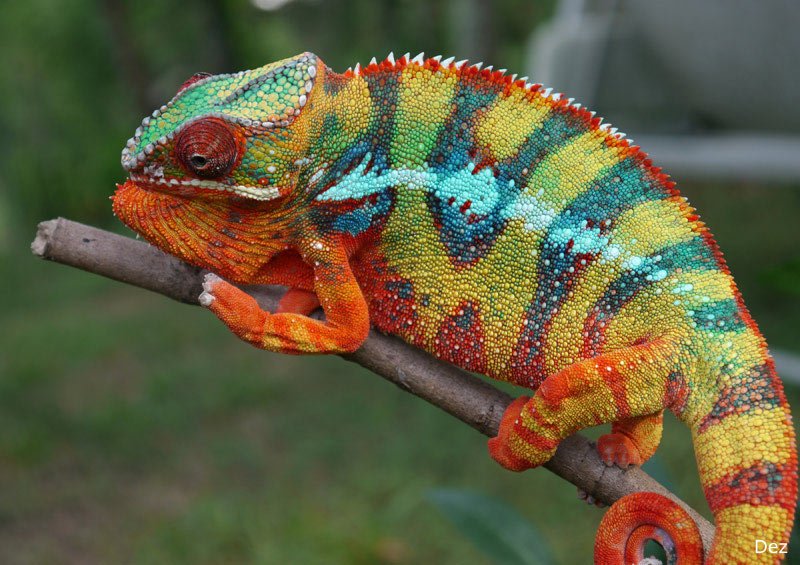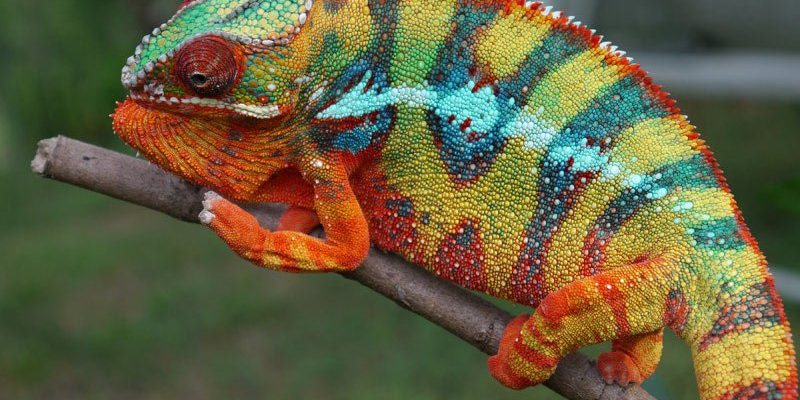
Where to Find Panther Chameleons
Panther chameleons are native to Madagascar, residing mainly in tropical forests, coastal areas, and sometimes even in gardens of villages. Picture these reptiles basking on branches, soaking up the sun, or perched among colorful flowers. They thrive in warm, humid climates, and they love to blend in with their surroundings.
If you’re looking for these chameleons, focus on areas rich with flowering plants. They often hide, but when the sun is shining, you might catch a glimpse of their vibrant colors. Patches of sunlight filtering through leaves can be a perfect spot to find them as they absorb heat. To truly spot a panther chameleon, patience and a keen eye are your best allies.
Spotting Color Patterns
One of the most distinctive features of the panther chameleon is its color. These small reptiles are famous for their ability to change color, but it’s not as simple as flipping a switch. Their coloration reflects their mood and environment. When they’re excited or ready to mate, they may display stunning blues, greens, and oranges.
It’s fascinating to note that male chameleons tend to have brighter colors than females. Imagine standing still and observing how the light dances off their scales, revealing different shades as they move. If you see a chameleon that’s mostly blue with orange spots, it’s likely a male. On the other hand, females generally showcase more subdued hues, like browns and muted greens, often with a hint of pink or orange.
Physical Characteristics
Knowing a few physical traits can also help you identify a panther chameleon. Firstly, they have a distinctive body shape. Their bodies are somewhat elongated, and they possess a prehensile tail, which means they can grasp branches and keep a firm hold while navigating their treetop homes.
Their large, bulging eyes are another giveaway. Each eye moves independently, allowing them to survey their surroundings without moving their heads—imagine watching two different things at once! Additionally, their toes are specialized for gripping, with two toes pointing forward and two backward, similar to how some lizards are built.
Behavioral Cues
Behavior can offer insightful clues for identifying a panther chameleon in the wild. These reptiles are primarily diurnal, meaning they are active during the day. If you’re out exploring in the morning or early afternoon, you’re in luck! Look for them basking on branches or cautiously moving around, trying to blend in.
You might also notice display behaviors. During mating season, males become more aggressive and will often show off their colors to attract females. If you see one puffing up its body and bobbing its head, you’re witnessing a classic display of dominance and interest. Keep an eye out for any interactions between chameleons, as these behaviors can reveal their social dynamics.
Listening for Sounds
While chameleons aren’t known for being vocal, they can produce subtle sounds that might help in your identification journey. Sometimes, during mating rituals or territorial disputes, males might make low hissing or clicking sounds. Keep your ears open! If you’re close enough without startling them, these sounds can be a fascinating clue to their presence.
For example, if you’re quietly observing and hear a soft hiss nearby, it could be a chameleon warning you to back off. This behavior showcases their defensive side and can make your wildlife watching even more engaging.
Environmental Context
The habitat surrounding the panther chameleon is as important as the chameleon itself. Understanding their environment can lead you to them. They love lush vegetation with plenty of cover to hide and hunt for insects. Look for places with abundant foliage, flowers, and trees.
In Madagascar, the chameleons often inhabit areas with high humidity and diverse plant life. If you find yourself in a dry environment or a place with little greenery, it’s less likely you’ll spot one. Pay attention to the ecosystem—they thrive best where their favorite food sources, like insects, are plentiful.
Tips for Ethical Observing
While it’s exciting to spot a panther chameleon, it’s essential to remember the importance of ethical wildlife observation. Respect their space and environment. Avoid touching them or disturbing their natural behaviors. Instead, take pictures from a distance and enjoy the moment without causing stress to these beautiful creatures.
Consider using tools like binoculars to observe them closely without getting too close. This way, you can appreciate their beauty while ensuring they remain undisturbed and safe in their habitat.
In summary, identifying a panther chameleon in the wild combines keen observation, patience, and an understanding of their behavior and environment. Armed with the knowledge outlined above, you’ll feel more confident on your next adventure into their beautiful world. Remember to absorb every detail, from their stunning colors to the way they blend seamlessly into their surroundings. Happy chameleon spotting!

